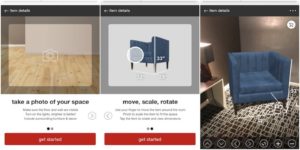
Furniture retailers are getting into the holiday spirit
Augmented Reality and Virtual Reality continue to disrupt traditional retail. With the Black Friday fast approaching, furniture retailers are embracing these new technologies as a way to wow customers and increase sales during the crucial holiday shopping season. Ikea, Amazon, Macy’s and Target are a few of the big-names seeing results from AR and VR right now, as shoppers and sales associate alike get their first taste of an AR- and VR-driven retail environment.
A recent survey by RetailMeNot, as covered in Forbes, shows just how big a deal the next month and a half will be to retailers. RetailMeNot polled 1,015 U.S. adult consumers and 201 “retail marketing decision makers” about holiday spending. The good news: Both consumers and retailers see a robust holiday shopping season on the horizon. Some key takeaways from the survey:
- 52% of consumers are planning to shop on Black Friday this year
- Consumer spending over Black Friday weekend is forecast to grow by 47% year over year
- Consumers plan to spend an average of $743 during the Black Friday-Cyber Monday period
- That’s up from an average of $505 over the same weekend last year
- Seven in 10 consumers are expected to shop over the Black Friday holiday weekend
- Cyber Monday keeps getting more popular: More than 56% of consumers surveyed saying they plan to make a purchase on Cyber Monday this year, compared with 39% last year
- In 2016, Cyber Monday was the largest online sales day in history, with shoppers spending a record $3.39 billion online on Cyber Monday last year, up 10.2% year over year and surpassing the Black Friday online sales total of $3.34 billion
In this hyper-competitive environment — where consumers are inundated with endless advertising messages — retailers of all stripes must find ways to differentiate their brands and products. It’s a big reason furniture retailers are turning to Augmented Reality and Virtual Reality sales solutions.
Two ways furniture retailers are using AR and VR this holiday season (and one they should consider):
1. In-store Virtual Reality
Department store giant Macy’s is going beyond AR with a Virtual Reality showroom tool currently in use at stores in New Jersey and Florida. For the Macy’s VR Experience, shoppers work with a concierge to build a 3D replica of their living room using an iPad design app. The shopper then wears an HTC Vive headset and previews furniture, rugs and other home goods in a realistic 3D VR approximation of their real world space.
“An interactive experience, the Virtual Reality initiative will enable customers to digitally furnish their living spaces using 3D furniture images. Facilitated by an iPad application and a Virtual Reality headset, the VR presentation allows customers to see how furniture items might look in their living spaces,” writes HomeWorld Business. “Other Macy’s holiday initiatives include the introduction of an 800-square-foot b8ta smart home product shop, already in operation, at Macy’s Herald Square location. Macy’s noted that b8ta is a software-powered retailer that works to make physical retail more engaging and accessible.”
Also using a VR Showroom approach is Ashley Furniture Industries, North America’s largest furniture retailer. Ashley has unveiled two incredible 3D product experiences: The Ashley 360 in-store Virtual Reality furniture showroom, and the Ashley HomeStore iPhone app. Powered by 3D Cloud™, Ashley 360 combines a robust iPad design app for space planning and scene configuration with photo-realistic 3D content with a 360-degree HTC Vive viewing experience, while the HomeStore iPhone app lets shoppers preview that same 3D content in their own home using Markerless Augmented Reality. Both implementations make it possible for customers to preview merchandise in a custom footprint (either real or virtual) before they buy.
2. Customer-facing Augmented Reality Apps
Thanks to the launch of Apple’s ARKit and Google’s ARCore SDKs, Augmented Reality shopping experiences are now available to hundreds of millions of iPhone, Galaxy, and Pixel users. This huge installed user base has led to a proliferation of AR apps that make previewing furniture in your own home the new default way consumers shop for furniture. Amazon’s AR View, Ikea Place, and apps from Target, Wayfair and others all feature View In Room AR implantations that let shoppers see products in their space — building buyer confidence in the process. Here are some of the best:
Amazon AR View
Amazon recently updated its existing iPhone app with “AR View,” which promises to let users view products in their homes before purchasing. “Curious whether a throw pillow is the right shade of blue, or whether a mixer you like will fit under the counter? Now just pull out your phone to find out,” Amazon promises.
Target “See It In Your Space”

Target is no stranger to innovation, which helps explain the retailer’s aggressive moves to add features to its mobile website. “See It In Your Space” is one such example. “Guests shopping the new Project 62 line can use the feature to place three-dimensional versions of real Target home products within photos of actual rooms at home, and move them around at proper scale to see how they’d look,” Target promises. “See It In Your Space” already features hundreds of furniture and home goods products, but that’s just the beginning. Target plans to add thousands of products from a wide selection of brands in the coming year.
IKEA Place
Ikea was one of Apple’s AR launch partners, and the IKEA Place app has become the measuring stick by which all furniture placement apps are measured. IKEA enjoyed early access to ARKit, and as such the app is a smooth and visually impressive example of how AR technology enhances the shopping process.
Wayfair
Online furniture retailer WayFair’s original AR app ran on Google’s Tango platform. Tango is a robust markerless Augmented Reality platform that combined dedicated hardware and software to deliver an amazing AR experience long before ARKit was even a figment of developer’s imaginations. Unfortunately for Wayfair, Tango never took off (turns out that dedicated hardware was a tough sell to a public conditioned to the small size and ease of use of the iPhone, Galaxy, and other smartphones. WayFair quickly adapted though, and the company’s iOS app now offers “3D View In Room” as an ARKit-powered feature.
3. In-store Augmented Reality
Toys R Us Play Chaser App
One retailer that specializes in something other than furniture or home goods has found an innovative way to use Augmented Reality as part of the in-store shopping experience. Toys R Us has rolled out “Play Chaser,” a smartphone app that combines traditional handheld games with more eye-catching AR features. Or, as the app store description puts it: “Use your phone as a personal magic wand and scan Play Chaser signs throughout the store to trigger awesome Augmented Reality 3D experiences, unlock cool games, access exclusive content, complete quests, and collect valuable stars.”
While this type of “gamification” of the shopping experience is ideal for a kid-friendly retailer like Toys R Us, the implications for the rest of retail are staggering. Expect to see other retailers roll our apps similar to Play Chaser that leverage the uniqueness of their brands to make in-store shopping more fun and exciting than it is today.










